King George V (George V, by the Grace of God, of Great Britain, Ireland and the British Dominions beyond the Seas, King, Defender of the Faith, Emperor of India) (born 3 June 1865 at Marlborough House, London, United Kingdom; died 20 January 1936 at Sandringham House, Norfolk, United Kingdom). The grandfather of Queen Elizabeth II, George V reigned during the First World War. His reign included key innovations that continue to shape the modern constitutional monarchy, including the Balfour Report of 1926 and the 1931 Statute of Westminster. George visited Canada three times, including a month-long tour across Canada by train in 1901.

Early Life and Education
Prince George Frederick Ernest Albert was born in the reign of his grandmother, Queen Victoria. He was the second son of the Prince and Princess of Wales (the future King Edward VII and Queen Alexandra). George and his elder brother, Albert Victor, were tutored at home and spent their adolescence training as naval cadets.
Naval Career
In 19th-century Europe, the navy was a popular career for younger sons and brothers of monarchs, and “sailor princes” were admired by the public. During his naval service, George travelled around the world. In 1883, he visited his aunt and uncle, Princess Louise and Governor General Lord Lorne, at Rideau Hall in Ottawa; he also travelled to Toronto and Niagara Falls.
In 1892, George’s elder brother, Albert Victor, died during the Russian flu pandemic, which may have been a coronavirus. George’s active naval career ended, and he assumed full-time royal duties as second in line to the throne. He became Duke of York in 1892.
Marriage and Children
On 6 July 1893, George V married his late brother’s fiancée, Princess Mary of Teck. The Countess of Derby, the wife of former Governor General Lord Stanley, presented the couple with a gift from Canada, described in the Globe newspaper as “two fine horses and a sleigh.”
George and Mary had six children: Prince Edward (1894–1972, reigned as King Edward VIII in 1936); Prince Albert, Duke of York (1895–1952, reigned as King George VI from 1936 to 1952); Princess Mary, Princess Royal (1897–1965); Prince Henry, Duke of Gloucester (1900–1974); Prince George, Duke of Kent (1902–1942); and Prince John (1905–1919).
1901 Royal Tour and 1908 Tercentenary of Quebec City
Queen Victoria died in 1901, and George V’s father succeeded to the throne as King Edward VII. That same year, George and Mary, now the Duke and Duchess of Cornwall and York, toured the British Empire, including Canada.
George returned to Canada as Prince of Wales in 1908 for the tercentenary of the founding of Quebec City. He reviewed the Canadian militia on the Plains of Abraham and presented a cheque for 90,000 pounds to help the Canadian government purchase land to establish the Battlefields Park. (See also Battle of the Plains of Abraham.) George wrote to his father, “I hope my visit has done good, especially to improve the relations between the English and French Canadians, which have never been so good as they are now.”
Accession to the Throne
On 6 May 1910, Edward VII died, and George V succeeded to the throne. The coronation took place at Westminster Abbey in London on 22 June 1911. Canada sent about 700 civilian dignitaries and military personnel to be part of the celebrations in London.

First World War
On 4 August 1914, the United Kingdom, as well as the British Empire and its Dominions, including Canada, entered the First World War. George V frequently toured the Western Front and met with military personnel, including members of the Canadian Expeditionary Force. He knighted General Arthur Currie on the battlefield at Vimy Ridge in June 1917. George also corresponded with the Governor General of Canada (his uncle Prince Arthur, Duke of Connaught) about conditions on the home front in Canada.

House of Windsor
In 1917, George V proclaimed the royal family the House of Windsor, replacing the German name Saxe-Coburg-Gotha, which was introduced by Queen Victoria’s husband, Prince Albert. Other royal relatives with German surnames received anglicized surnames as well. The Battenbergs became the Mountbattens, and the Tecks became the Cambridges and Athlones. George also restricted the title of HRH Prince or Princess to children and male line grandchildren of the monarch.
Modern Monarchy
George V introduced innovations that changed the way monarchs engaged with the public. George and Mary visited working-class homes and inquired about the living conditions of people from all walks of life. George’s straightforward and unpretentious manner endeared him to the public. In 1932, he delivered the first royal Christmas Broadcast over the radio to a worldwide audience of about 20 million people.
Canadian Crown
In 1926, George V hosted an Imperial Conference in London attended by Dominion leaders, including Canadian Prime Minister William Lyon Mackenzie King. The conference resulted in the Balfour Report of 1926, which declared the United Kingdom and its Dominions “autonomous communities in the British Empire equal in status.” In 1931, the Statute of Westminster gave the Dominions legal autonomy and control of their own foreign policy. These developments were crucial to the emergence of the modern Commonwealth and the independent Canadian Crown.

Silver Jubilee and Death
In 1935, George V celebrated his Silver Jubilee and received widespread public acclaim. The King George’s Jubilee Trust raised more than one million pounds “to promote the welfare of the younger generation,” setting precedents for future royal philanthropy.
George turned 70 that same year, and his health declined rapidly. He was a heavy smoker who suffered from chronic bronchitis and had never fully recovered from a 1928 attack of septicaemia. George’s physician, Lord Dawson, recorded in his diary that, after the king slipped into a coma, he had injected the monarch with a fatal dose of morphine and cocaine to ensure a painless death that would be announced “in the morning papers rather than the less appropriate evening journals.” The funeral took place in Windsor on 28 January 1936, which was declared a day of mourning in the British Empire and Dominions, including Canada.


 Share on Facebook
Share on Facebook Share on X
Share on X Share by Email
Share by Email Share on Google Classroom
Share on Google Classroom




